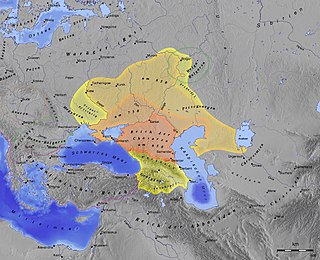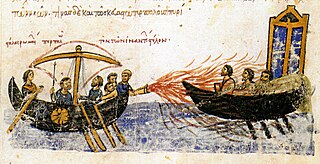
The Khazars were a nomadic Turkic people that, in the late 6th-century CE, established a major commercial empire covering the southeastern section of modern European Russia, southern Ukraine, Crimea, and Kazakhstan. They created what for its duration was the most powerful polity to emerge from the break-up of the Western Turkic Khaganate. Astride a major artery of commerce between Eastern Europe and Southwestern Asia, Khazaria became one of the foremost trading empires of the early medieval world, commanding the western marches of the Silk Road and playing a key commercial role as a crossroad between China, the Middle East and Kievan Rus'. For some three centuries the Khazars dominated the vast area extending from the Volga-Don steppes to the eastern Crimea and the northern Caucasus.

Sviatoslav or Svyatoslav I Igorevich was Prince of Kiev from 945 until his death in 972. He is known for his persistent campaigns in the east and south, which precipitated the collapse of two great powers in Eastern Europe, Khazaria and the First Bulgarian Empire. He conquered numerous East Slavic tribes, defeated the Alans and attacked the Volga Bulgars, and at times was allied with the Pechenegs and Magyars (Hungarians).

The Russian Primary Chronicle, commonly shortened to Primary Chronicle, is a chronicle of Kievan Rus' from about 850 to 1110. It is believed to have been originally compiled in or near Kiev in the 1110s. Tradition ascribed its compilation to the monk Nestor beginning in the 17th century, but this is no longer believed to have been the case.
The Grand Prince of Kiev was the title of the monarch of Kievan Rus', residing in Kiev from the 10th to 13th centuries. In the 13th century, Kiev became an appanage principality first of the grand prince of Vladimir and the Mongol Golden Horde governors, and later was taken over by the Grand Duchy of Lithuania.

Oleg, also known as Oleg the Wise, was a Varangian prince of the Rus' who became prince of Kiev, and laid the foundations of the Kievan Rus' state.

Igor was Prince of Kiev from 912 to 945. Traditionally, he is considered to be the son of Rurik, who established himself at Novgorod and died in 879 while Igor was an infant. According to the Primary Chronicle, Rurik was succeeded by Oleg, who ruled as regent and was described by the chronicler as being "of his kin".

Hasdai ibn Shaprut born about 915 at Jaén, Spain; died about 970 at Córdoba, Andalusia, was a Jewish scholar, physician, diplomat, and patron of science.
The Khazar Correspondence is a set of documents, which are alleged to date from the 950s or 960s, and to be letters between Hasdai ibn Shaprut, foreign secretary to the Caliph of Cordoba, and Joseph Khagan of the Khazars. The Correspondence is one of only a few documents attributed to a Khazar author, and potentially one of only a small number of primary sources on Khazar history.
Bulan was a Khazar king who led the conversion of the Khazars to Judaism. His name means "elk" or "hart" in Old Turkic. The date of his reign is unknown, as the date of the conversion is hotly disputed, though it is certain that Bulan reigned some time between the mid-8th and the mid-9th centuries. Nor is it settled whether Bulan was the Bek or the Khagan of the Khazars.
The Krymchaks are Jewish ethno-religious communities of Crimea derived from Turkic-speaking adherents of Rabbinic Judaism. They have historically lived in close proximity to the Crimean Karaites, who follow Karaite Judaism.
Obadiah was the name of a Khazar ruler of the late eighth or early ninth century. He is described as coming from among "the sons of the sons" of Bulan, but whether this should be taken literally to mean that he was Bulan's grandson, or figuratively to imply a more remote descent, is unclear. King Joseph's Reply claimed that Obadiah strengthened Rabbinic Judaism and Hebrew proficiency in Khazaria by building synagogues and schools and inviting Jewish sages to the country. In Sefer ha-Ittim, Judah ben Barzillai's list of Khazar Jewish kings lacked Obadiah's name, and several scholars have concluded from this that Obadiah was a fictional character. He was succeeded by his son Hezekiah.
The Bulanids were the ruling dynasty of the Khazar Khaganate during the 9th century and 10th century CE.
Pesach or Pesakh was a Khazar Jewish general mentioned in the Schechter Letter.
In the Schechter Letter, Serach is married to the Khazar ruler Sabriel. A Jew, she encourages her husband and other Khazars to convert to Judaism and establish it as the official religion of Khazaria. Serach is not mentioned in the Khazar Correspondence or the Kuzari.
Constantin Zuckerman is a French historian and Professor of Byzantine studies at the Ecole Pratique des Hautes Etudes in Paris.

The Caspian expeditions of the Rus' were military raids undertaken by the Rus' between the late 9th century and c. 1041 on the Caspian Sea shores, of what are nowadays Iran, Dagestan, and Azerbaijan. Initially, the Rus' appeared in Serkland in the 9th century travelling as merchants along the Volga trade route, selling furs, honey, and slaves. The first small-scale Viking raids took place in the late 9th and early 10th century. The Rus' undertook the first large-scale expedition in 913; having arrived on 500 ships, they pillaged in the Gorgan region, in the territory of present-day Iran, and more to the west, in Gilan and Mazandaran, taking slaves and goods. On their return, the northern raiders were attacked and defeated by the Khazars in the Volga Delta, and those who escaped were killed by the local tribes in the middle Volga.

The Rus'–Byzantine War of 941 took place during the reign of Igor of Kiev. The first naval attack was driven off and followed by another, successful offensive in 944. The outcome was the Rus'–Byzantine Treaty of 945.
Rusʹ Khaganate, or kaganate of Rus is a name applied by some modern historians to a hypothetical polity suggested to have existed during a poorly documented period in the history of Eastern Europe between c. 830 and the 890s.
The Conversion of Volodimer is a narrative recorded in several different versions in medieval sources about how Vladimir the Great converted from Slavic paganism to Byzantine Christianity in the 980s.








